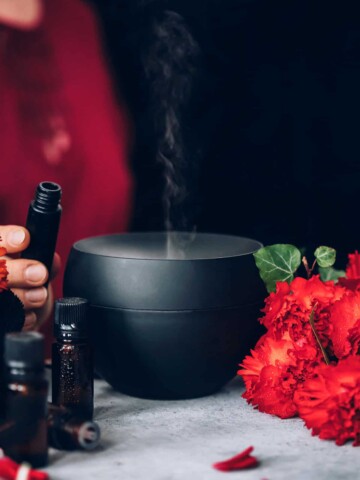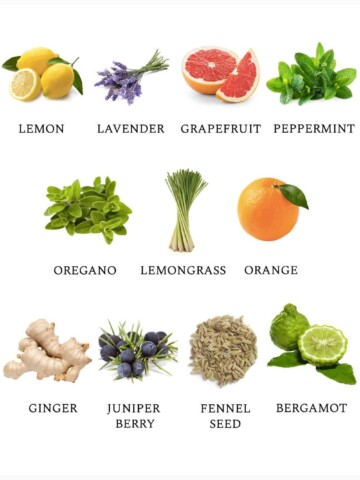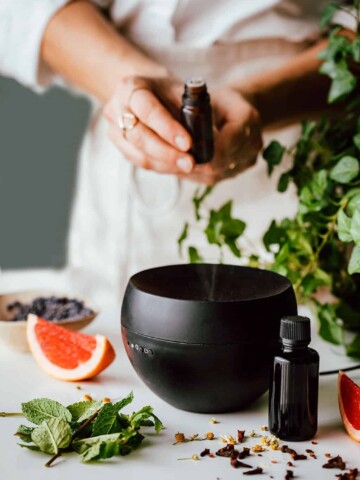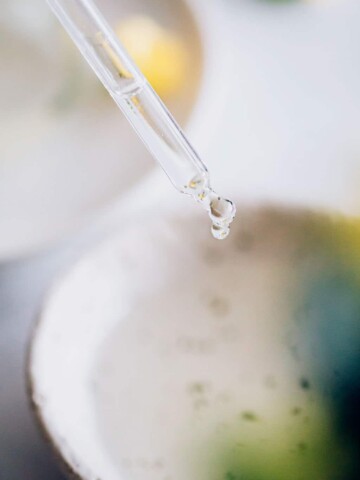Keep your skin gorgeous—and fight acne, aging, and dryness—with the best essential oils for every skin type. Add these potent botanicals to your daily routine with easy homemade beauty recipes and your skin will thank you!

As an esthetician, I’ve spent a lot of time researching the most beneficial essential oils for the skin. These are the ones I use most with my clients along with ways to use them in homemade beauty products.
Jump to:
- Best Essential Oils for Oily + Acne-Prone Skin
- 1. Bergamot
- 2. Cedarwood
- 3. Cypress
- 4. Juniper Berry
- 5. Tea Tree
- Best Essential Oils for Combination Skin
- 1. Basil
- 2. Clary Sage
- 3. Geranium
- 4. Rosemary
- 5. Ylang Ylang
- Best Essential Oils for Dry Skin
- 1. Lavender
- 2. Roman chamomile
- 3. Rose
- 4. Sandalwood
- 5. Patchouli
- Best Essential Oils for Aging Skin
- 1. Carrot Seed Oil
- 2. Frankincense
- 3. Helichrysum
- 4. Myrrh
- 5. Neroli
- Top Tip
- References
Best Essential Oils for Oily + Acne-Prone Skin
Essential oils can be particularly beneficial for managing oily and acne-prone skin due to their natural antiseptic, antibacterial, and anti-inflammatory properties.
- Essential oils: bergamot, cedarwood, clary sage, cypress, geranium, grapefruit, juniper, lemon, tea tree
- Carrier oil: tamanu oil, apricot kernel, grapeseed
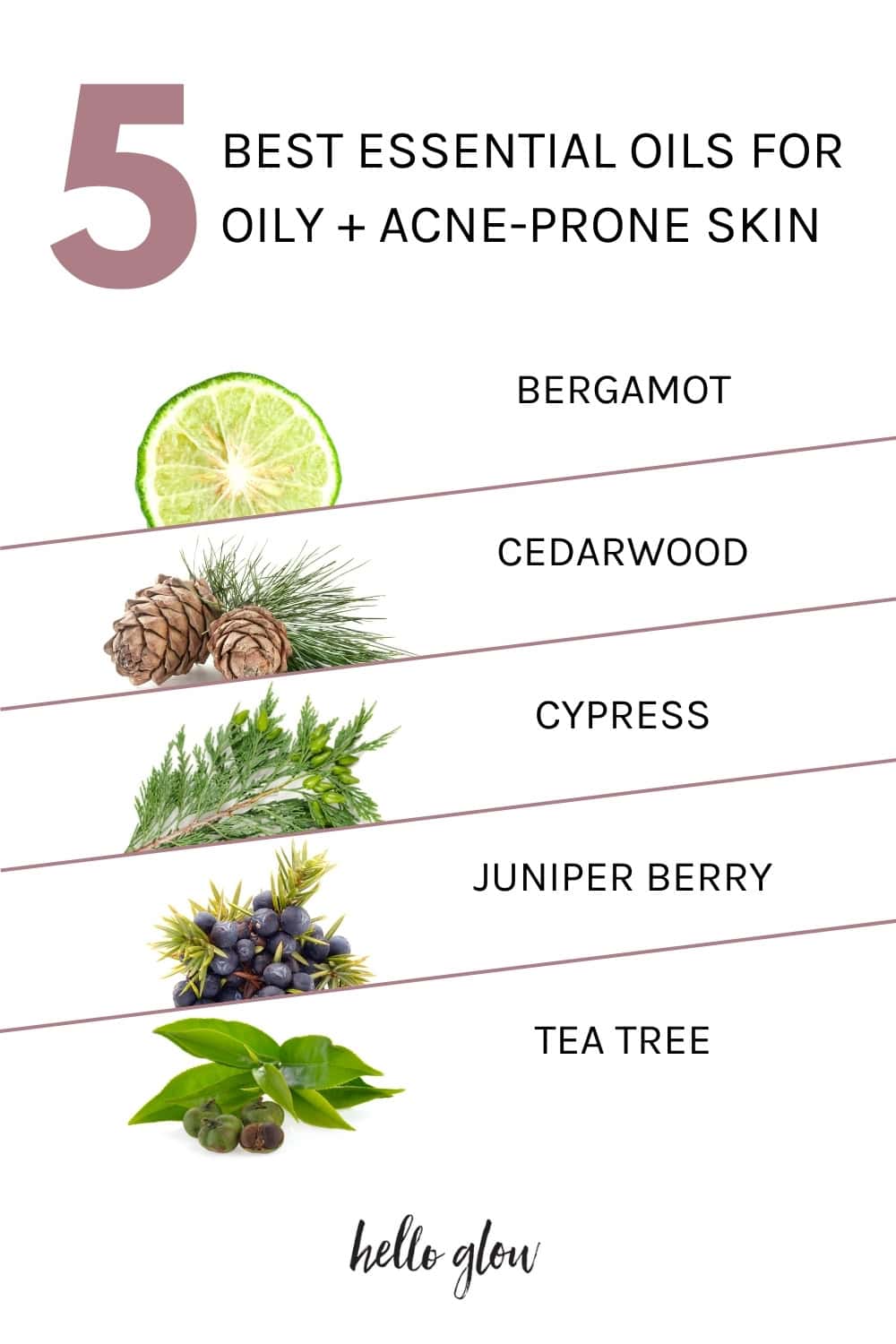
1. Bergamot
Citrus oils like bergamot, lemon, and grapefruit are natural astringents that work to cleanse oil-prone skin while toning and tightening. Their antiseptic properties [source] also help protect against acne-causing bacteria. Grapefruit oil is especially helpful in breaking down cellulite.
Use It In: Clay Masks
Clay absorbs excess oil and impurities while the essential oils provide additional skin benefits like reducing redness and preventing breakouts.
Add a few drops of essential oil to a base of clay (such as bentonite or kaolin). Mix with water or apple cider vinegar to form a paste, apply to the face, and leave on until dry before rinsing off.
More ideas: Add a couple of drops of lemon EO to a foaming face wash, or use grapefruit in a cellulite body oil. And this lavender lemonade body spray is the perfect pick-me-up on a hot day.
2. Cedarwood
Cedarwood has the highest level of the anti-inflammatory substance sesquiterpene of any essential oil, according to the book Essential Oils. That’s why it works so well on inflamed and acne-prone skin. Cedarwood is also an effective toner on oily skin and hair.
Use It In: Cleansing Oil Blend
Create a mix of carrier oils like grapeseed or hemp seed oil with a few drops of essential oils. Use this blend to cleanse your face with the oil cleansing method to help dissolve excess sebum and impurities in the pores without stripping the skin of its natural oils.
More ideas: This calming bath oil doubles as a skin-soothing body oil. Cedarwood oil’s anti-itch and anti-inflammatory properties are especially helpful in this homemade eczema balm.
3. Cypress
Cypress oil can not only help repair capillary vein damage often found around the nose area, but it also shrinks swollen blood vessels. It’s considered beneficial for varicose veins, according to The Complete Book of Essential Oils and Aromatherapy. This essential oil is also a good choice to use as an astringent on the skin, to kill bacteria [source], or to tackle cellulite.
Use It In: Spot Treatments
Dilute an essential oil with a carrier oil like jojoba, which closely mimics the skin’s natural oils. Apply the spot treatment directly to blemishes using a cotton swab to reduce inflammation and promote faster healing without overly drying the skin.
More ideas: Add cypress to homemade deodorant for a naturally spicy aroma. Or apply it directly to cracked cuticles with nail oil.
4. Juniper Berry
Juniper is a cleansing oil, and when diluted (as is always necessary) and applied to wounds, its antimicrobial properties [source] can speed healing time and help prevent infections [source].
It’s a great choice for many different skin issues, including oily skin and acne. The Art of Aromatherapy considers it beneficial for toning the skin and for use with skin disorders associated with irritation.
Use It In: Facial Steam
Add a few drops of essential oil to a bowl of hot water for a DIY facial steam. Drape a towel over your head and lean over the steam for 5-10 minutes to open pores and let the essential oils penetrate deeply to cleanse and reduce oiliness.
More ideas: Attack lumps and bumps with a DIY anti-cellulite oil that uses juniper EO to clear waste from the body and increase circulation.
5. Tea Tree
The uses for tea tree oil for skin are countless [source]. A few of them include its antifungal and antibacterial properties.
This means it’s a first choice for acne and oily skin. Tea tree EO can also treat minor cuts, scrapes, and just about any other skin condition you may experience.
Use It In: Toner
Make a tea tree toner with a few drops of essential oil combined with distilled water or apple cider vinegar. Store in a clean bottle and use a cotton pad to apply the toner to the face after cleansing to help restore pH balance, reduce excess oil, and tighten pores.
More ideas: Try these tea tree acne remedies or use the oil to make your own make-up remover wipes.
Best Essential Oils for Combination Skin
Combination skin, characterized by having both oily and dry areas, can benefit from a strategic approach using essential oils.
- Essential oils: basil, clary sage, geranium, rosemary, ylang ylang
- Carrier oil: grapeseed, jojoba, squalane
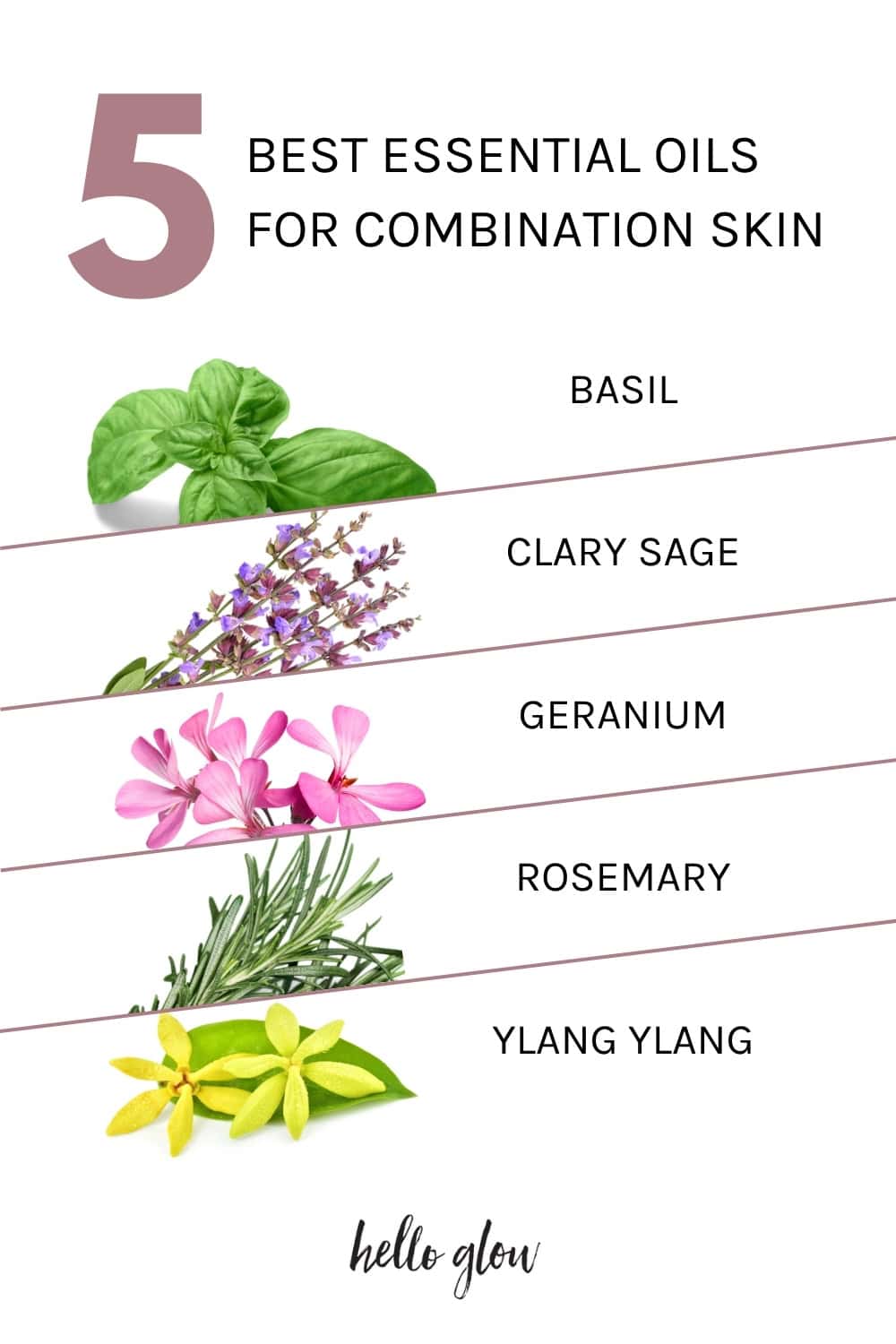
1. Basil
Basil has natural anti-inflammatory and antimicrobial properties, making it excellent for controlling excess oil production in the oily zones of combination skin.
While controlling oiliness, basil also has soothing properties that can help calm dry, irritated areas of the skin. It can reduce redness and provide a mild hydrating effect, which is beneficial for the dry patches commonly found on cheeks and other areas in combination skin.
It’s also a good option to consider for overworked and inflamed muscles and even headaches and migraines. Please note that basil should be avoided if pregnant.
Use It In: Spot Treatment
Directly target specific problems on areas of the face by using different oils. Dilute 2 drops of basil in a teaspoon a carrier oil like jojoba oil and apply to blemishes in the oily zones. Simultaneously, you can use a soothing oil like chamomile mixed with sweet almond oil on dry or irritated patches.
More ideas: I like to use it for soothing insect bites. Just add a couple of drops to a carrier oil and apply directly to an insect bite or sting. If you are feeling sore from an extra hard workout, add a few drops into a massage oil to massage tired muscles.
2. Clary Sage
Clary sage EO not only fights the visible signs of aging and reduces puffiness, but it also regulates the production of oil for both dry and oily skin. This makes it useful for all skin types.
And due to its antibacterial properties [source], it’s considered helpful for treating acne as well [source].
Use It In: Hydrating and Balancing Serum
Blend clary sage with a lightweight, non-comedogenic moisturizer. This can help manage the different needs of combination skin by providing moisture without increasing oiliness.
Combine clary sage and lavender, which calms the skin, in a base of squalane oil. Squalane is non-comedogenic and moisturizing, making it ideal for combination skin as it won’t clog pores or feel too heavy. Apply this serum at night to help balance and moisturize the skin.
3. Geranium
Geranium is a versatile oil that balances oil production, conditions skin, and works well for all skin types. This essential oil can be added to moisturizers to help with the over- and underproduction of oils from the skin.
Geranium has antibacterial properties [source] and a delightful floral aroma with hints of rose in it. Not only can it boost the oil-balancing effects of any moisturizer, but it can also boost your mood at the same time!
Use It In: Customized Face Oil Blend
Create a face oil blend by mixing a few drops of essential oils like geranium, which balances sebum production, and lavender, which soothes, with a carrier oil that's good for all skin types, such as jojoba or grapeseed oil.
Apply this blend to the face, focusing on the oily T-zone and dry areas to help regulate oil production in oily areas while providing necessary hydration to dry spots.
More ideas: Add geranium EO to mineral water for a moisturizing face mist.
4. Rosemary
Rosemary essential oil has natural astringent properties, making it effective at balancing sebum production and reducing oiliness in the T-zone. Rosemary oil is known for its ability to stimulate blood circulation, which not only promotes a more vibrant complexion but can also help stimulate hair growth.
Use It In: Toner for Balancing Skin
Combine a witch hazel toner with a few drops of essential oil in a spray bottle. Use it as a toner after cleansing by spraying it directly onto the skin or applying it with a cotton pad to help refine pores in oily areas and hydrate and soothe dry patches, promoting an even skin tone.
More ideas: Add a few drops of rosemary oil to a bowl of hot water and use it for a facial steam. This helps deeply cleanse the pores, especially in oily areas, while also hydrating and soothing the entire face.
5. Ylang Ylang
Ylang ylang is excellent for treating oily or dry skin while still helping to stimulate cell growth and fight the effects of aging [source]. It’s a wonderful EO to add to any skincare routine.
And with its exotic aroma, it’s also great at boosting your mood. However, a little goes a LONG way with ylang ylang’s powerful aroma, so only a very small amount is needed. Using too much can even cause headaches or nausea.
I like to combine it with other essential oils beneficial for skin health to create a luxurious and effective product.
Use It In: Dual-Action Face Mask
Treat the specific needs of different areas of your face simultaneously by multi-masking. Prepare a clay mask with green clay for the T-zone to absorb excess oil and a creamier, hydrating mask with ingredients like honey and a few drops of rose oil for dry areas.
More ideas: Add ylang ylang EO to almond oil for a moisturizing face oil.
Best Essential Oils for Dry Skin
Dry skin can benefit significantly from the hydrating and soothing properties of essential oils.
- Essential oils: clary sage, lavender, sandalwood, ylang ylang
- Carrier oil: avocado, sweet almond, argan
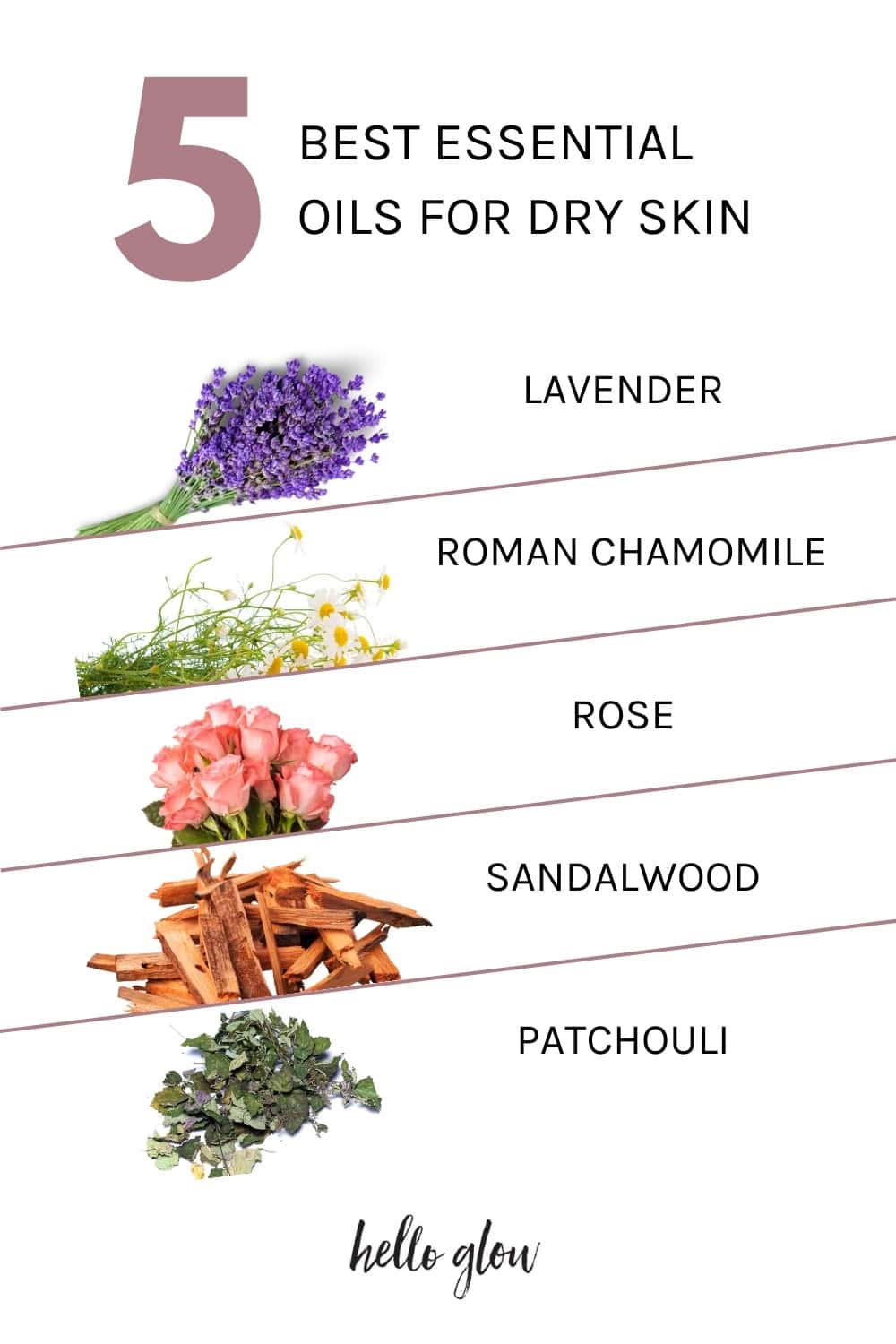
1. Lavender
This essential oil is frequently used for skin irritations and because it is so versatile, it can be used for all skin types. Its antibacterial properties make it beneficial for cuts, scrapes, burns, and irritations and it's also great for stressed skin.
Lavender is often used for acne and redness and is frequently used in DIY body products. It can be especially helpful for sensitive or problem skin but can be used for any skin type, including mature skin.
Use It In: Night Cream Boost
Add a few drops of essential oils to your regular night cream. Mix well and apply to your face before bedtime. Enhancing your night cream with essential oils helps regenerate the skin overnight, reducing dryness, and promoting a healthy glow.
More ideas: Use lavender with chamomile for a soothing balm that can also soften cracked heels.
2. Roman chamomile
Chamomile has a delightful aroma and is frequently used for a variety of skin conditions which include cracked skin, burns, acne, eczema, inflammation, sensitive skin and rosacea—just to name a few. It’s naturally anti-inflammatory and calming, making it a great choice for sensitive and irritated skin.
Use It In: Soothing Bath Oil
Relax in a bath with calming bath oil that won’t irritate your skin! Bathing with essential oils not only hydrates the skin but also provides a relaxing experience, helping to reduce stress which can exacerbate skin dryness.
Add 10-15 drops of essential oil to a mixture of carrier oils (e.g., jojoba, coconut) and add this blend to your bathwater.
3. Rose
Intensely hydrating and naturally anti-inflammatory, rose oil plumps and moisturizes your skin without any chemical side effects. Rose EO can be used as a natural substitute for hyaluronic acid, a common ingredient in beauty products for dry skin.
An added bonus is that it is also known to elevate your mood [source].
Use It In: Moisturizing Serum Blend
This natural serum provides deep hydration and can help repair the skin's barrier, reducing dryness and flakiness. Mix a few drops of essential oil with a carrier oil that is beneficial for dry skin, like sweet almond, argan, or avocado oil. Apply a few drops of this blend to your face after cleansing, particularly at night.
The hydrating effects of rose oil will plump up pesky lines around your eyes and mouth, so add it to your custom facial oil or make a serum with rosehip oil.
4. Sandalwood
This restorative essential oil effectively soothes the inflammation caused by overly dry skin [source]. And it’s an antiseptic with pretty powerful antibacterial properties [source]. It has been said that this EO can also reduce hyperpigmentation and the appearance of scars.
Use It In: Hydrating Face Mask
Add a couple of drops of essential oil to a hydrating face mask base, such as honey, yogurt, or mashed avocado. Apply the mask to your face, leave it on for 15-20 minutes, then rinse off with warm water.
This helps infuse the skin with moisture and essential nutrients, soothing dryness and improving skin texture.
More ideas: Add 6–10 drops of sandalwood oil to 1 tablespoon of almond oil and use it as a post-shave body oil to reduce irritation. To fight age spots or other skin discoloration, dab the diluted oil onto the skin each night before going to bed and leave it on overnight.
5. Patchouli
Patchouli is known for its moisturizing abilities. It helps to soothe dry skin and improves the skin's ability to retain moisture. It also improves skin elasticity and promotes the growth of new skin cells, which can help in healing dry, cracked skin.
Use It In: Daily Skin Mist
Combine essential oils with hydrating ingredients like rosewater or aloe vera gel in a spray bottle. Mist over your face throughout the day to refresh and hydrate your skin. This helps keep the skin moisturized throughout the day, especially in dry climates or air-conditioned environments.
More ideas: Mix patchouli with a carrier oil like coconut, jojoba, or sweet almond oil and apply the body oil after showering to lock in moisture.
Best Essential Oils for Aging Skin
Aging skin can benefit from the regenerative and protective properties of essential oils, which can help reduce the appearance of wrinkles, improve skin elasticity, and enhance overall skin health.
- Essential oils: carrot seed, clary sage, frankincense, helichrysum, myrrh, neroli, rose
- Carrier oil: rosehip seed, pomegranate
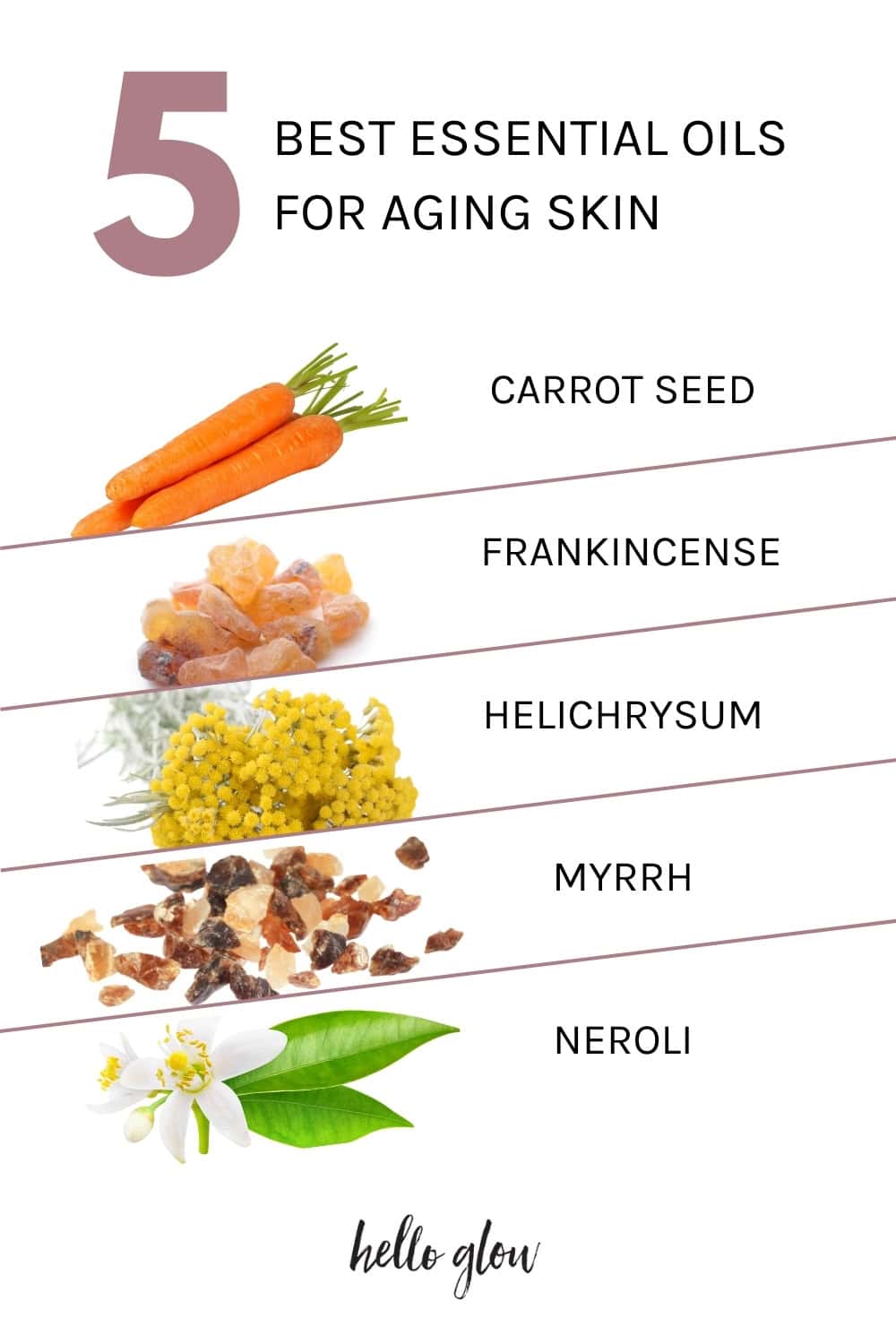
1. Carrot Seed Oil
Carrot seed oil is loaded with antioxidants, which are critical in fighting against free radicals that cause oxidative stress and damage to the skin cells. The oil is known for its ability to stimulate cell growth and repair and can enhance the elasticity of the skin, making it firmer and tighter.
Carrot seed oil has a natural SPF. It's not a replacement for traditional sunscreen, but it can provide an additional layer of protection against harmful UV rays, which are a significant factor in skin aging.
Use It In: Anti-Aging Serum
Blend carrot seed oil with essential oils like frankincense, which promotes cell regeneration, or rose, which is rich in antioxidants, with a carrier oil rich in vitamins and antioxidants, such as rosehip or argan oil. Apply this natural serum nightly after cleansing and before moisturizing to help reduce the appearance of fine lines and wrinkles, and improve skin tone and texture.
More ideas: Add carrot seed to a hydrating lip oil or add it to SPF lip balm.
2. Frankincense
Frankincense is an incredibly popular EO, and it’s no wonder. If you are treating aging skin, have elasticity issues, or need to regenerate skin cells, frankincense is your ideal oil. It can even help with pigmentation, as well as tone and tighten skin.
It’s also useful for treating cuts, wounds, and infections [source] due to its powerful antiseptic and anti-inflammatory properties [source]. Since it has a distinct woody aroma, I like to combine it with other essential oils that support skin health.
Use It In: Exfoliating Scrub
Blend a few drops of essential oil into a base of brown sugar and a carrier oil like coconut oil. Gently scrub your face once a week to remove dead skin cells and boost circulation. This scrub can brighten and even out the skin tone, while promoting the regeneration of skin cells, which is essential for aging skin.
More ideas: Make your own hand sanitizer + antiseptic spray.
3. Helichrysum
A tiny bottle of helichrysum is an investment. The nicknames for this healing oil with a honey-like scent are 'everlasting' and 'immortelle', which are perfect because helichrysum is a go-to oil for many. It has a long history of use for skin issues including bruises, scars, burns, wounds, eczema, and aging.
Use It In: Nightly Facial Oil
Mix essential oils known for their skin-rejuvenating properties with a carrier oil like pomegranate or evening primrose oil. Apply to your face and neck before bed.
These oils provide intense moisture and have powerful anti-aging properties that work overnight to improve skin elasticity and reduce the visibility of aging signs.
More ideas: Add helichrysum to a calendula-infused oil for an all-purpose first-aid oil. It also makes a great addition to homemade face oil.
4. Myrrh
Myrrh has long been added to skincare products to heal wounds and chapped skin [source], prevent sunburn, and restore sun-damaged skin [source]. Its skin-toning ability is especially helpful in fighting fine lines and other signs of aging.
Use It In: Rejuvenating Face Mask
Create a nourishing face mask to deeply hydrate the skin and provide essential nutrients that help in repairing and rejuvenating aged skin. Add myrrh to a simple homemade Aztec clay mask or a moisturizing mask with yogurt, honey, or mashed avocado. Apply the mask to your face, leave it on for about 20 minutes, then rinse off.
5. Neroli
Neroli is a wonderful essential oil used to treat devitalized, mature, aging, and sensitive skin types. Due to its regenerative properties, you can also use neroli as a skin toner to tighten aging skin.
It has antibacterial properties [source] and is considered useful for acne, scarring, and stretch marks. As you can see, it would be a fantastic addition to your natural skincare routine.
Use It In: Toning Face Mist
Follow this face mist recipe to combine witch hazel with a few drops of neroli in a spray bottle. Mist over your face after cleansing or throughout the day for a refreshing boost. This face mist helps to tighten and tone the skin while providing a hydrating and refreshing feel.
More ideas: Make an anti-stretch mark oil with avocado oil and neroli EO.
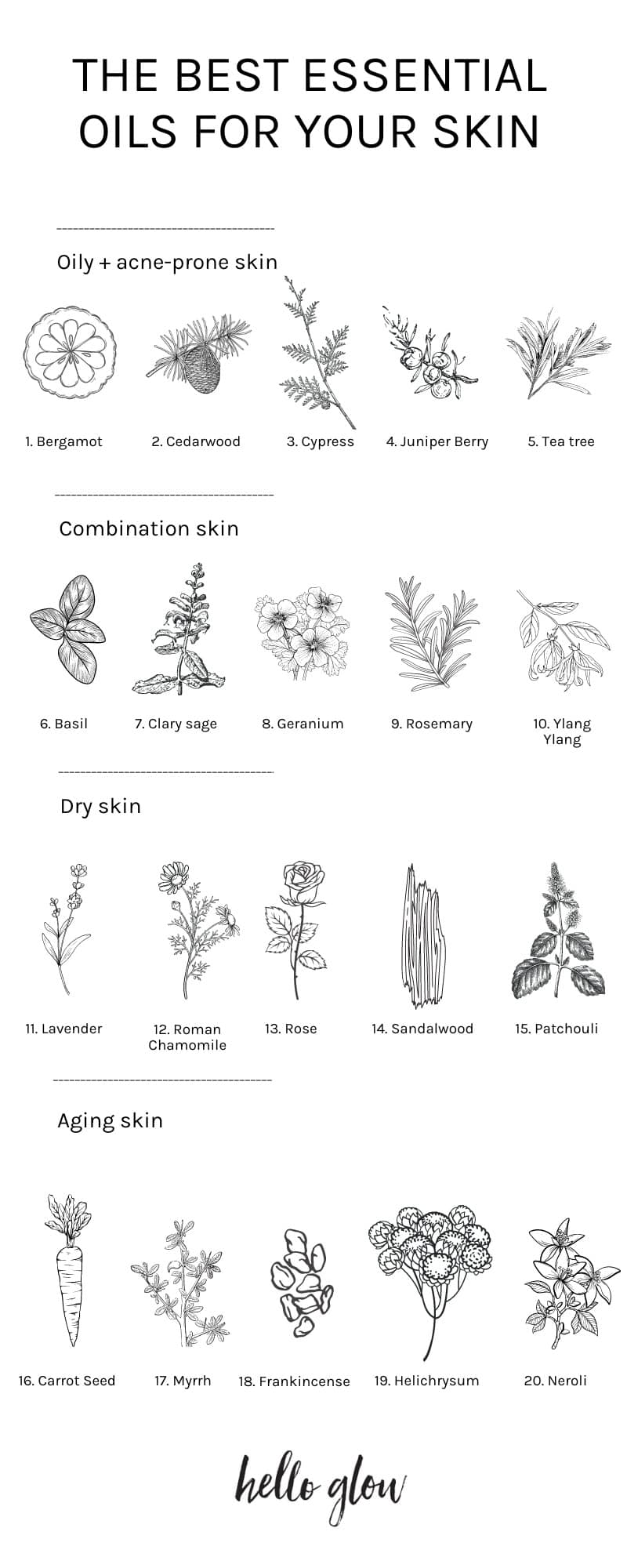
Top Tip
Keep in mind that the topical application of anything has the potential to cause an allergic reaction. Essential oils should always be used with a carrier oil or in a dilution blend to avoid a skin reaction. You should do a patch test with any oil blend before applying it to a larger area of skin.
And, while it is rare, if you develop any adverse reaction, such as a rash, itching, or burning at the site of application, discontinue the oil and bring this to your doctor’s attention.
References
References
Narnoliya LK, et al. The phytochemical composition, biological effects and biotechnological approaches to the production of high-value essential oil from geranium. Essential Oil Research. 2019.
Kramberger K, et al. HPLC-DAD-ESI-QTOF-MS Determination of bioactive compounds and antioxidant activity comparison of the hydroalcoholic and water extracts from two Helichrysum italicum species. Metabolites. 2020.
Nasri H, et al. Medicinal plants for the treatment of acne vulgaris: a review of recent evidences. Jundishapur J Microbiol. 2015.
Dosoky NS, et al. Biological activities and safety of Citrus spp. essential oils. Int J Mol Sci. 2018.
Bhaskaran N, et al. Chamomile, an anti-inflammatory agent inhibits inducible nitric oxide synthase expression by blocking RelA/p65 activity. Int J mol Med. 2010.
Miraj S, et al. A systematic review study of therapeutic effects of Matricaria recuitta chamomile (chamomile). Electron Physician. 2016.
Mohebitabar S, et al. Therapeutic efficacy of rose oil: a comprehensive review of clinical evidence. Avicenna J Phytomed. 2017.
Rabbani M, et al. Evaluation of anxiolytic and sedative effect of essential oil and hydroalcoholic extract of Ocimum basilicum L. and chemical composition of its essential oil. Res Pharm Sci. 2015.
Orhan IE, et al. Potential of Cupressus sempervirens (Mediterranean Cypress) in health. The Mediterranean Diet. 2015.
Elshafie HS, et al. Biological investigations of essential oils extracted from three Juniperus species and evaluation of their antimicrobial, antioxidant and cytotoxic activities. J Appl Microbiol. 2020.
Tumen I, et al. Topical wound-healing effects and phytochemical composition of heartwood essential oils of Juniperus virginiana L., Juniperus occidentalis Hook., and Juniperus ashei J. Buchholz. J Med Food. 2013.
Carson CF, et al. Melaleuca alternifolia (tea tree) oil: a review of antimicrobial and other medicinal properties. Clin Microbiol Rev. 2006.
Sienkiewicz M, et al. The effect of clary sage oil on staphylococci responsible for wound infections. Postepy Dermatol Alergol. 2015.
Orchard A, et al. Commercial essential oils as potential antimicrobials to treat skin diseases. Evid Based Complement Alternat Med. 2017.
Moy RL, et al. Sandalwood album oil as a botanical therapeutic in dermatology. J Clin Aesthet Dermatol. 2017.
Han Xuesheng, et al. Chemical composition analysis and in vitro biological activities of ten essential oils in human skin cells. Biochim Open. 2017.
Tan LTH, et al. Traditional uses, phytochemistry, and bioactivities of Cananga odorata (ylang-ylang). Evid Based Complement Alternat Med. 2015.
Sadhasivam S, et al. Synergistic antimicrobial activity of Boswellia serrata Roxb. ex Colebr. (Burseraceae) essential oil with various azoles against pathogens associated with skin, scalp and nail infections. Lett Appl Microbiol. 2016.
Hamidpour R, et al. Frankincense (乳香 Rǔ Xiāng; Boswellia species): from the selection of traditional applications to the novel phytotherapy for the prevention and treatment of serious diseases. J Tradit Complement Med. 2013.
Gebrehiwot M, et al. Evaluation of the wound healing property of Commiphora guidottii Chiov. ex. Guid. BMC Complement Altern Med. 2015.
Chakravarty N, et al. UV protection by natural products: C. myrrha oil versus sunscreen. J Drugs Dermatol. 2018.
This post was medically reviewed by Dr. Holly Smith, a board-certified physician in nephrology and internal medicine with a background in nutrition. Learn more about Hello Glow’s medical reviewers here. As always, this is not personal medical advice, and we recommend that you talk with your doctor.
559
